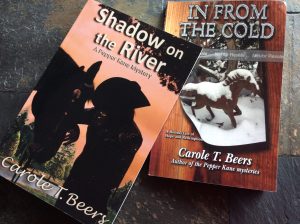

Three books published in one year? Hell, yeah. That was my output for 2019—two new Pepper Kane Mysteries, plus the holiday novella, “In From the Cold.” In a world where publishing one book a year is the norm or at least a goal, I gobsmacked even myself. How’d that happen?
My background, as many of you know, was in daily big-city journalism for nearly 40 years, and mainly for The Seattle Times. Features, hard news, obits, criticism and columns. Oh, I ground out some stories for romance and horse publications. But predominantly I was shaped by the values and daily discipline. Fine training for any writer—Hemingway and Faulkner, included!
Retiring in 2006 and moving back to Grants Pass, Oregon, where I graduated high school, I read voraciously, gardened, rested and competed in horse shows—all the things I couldn’t pursue as I liked while employed full time. I also wrote short stories as part of the Monday Mayhem fiction group. The stories were, for the most part, less than stellar. I soon learned writing fiction is way different than doing journalism! You invent characters, settings, plots, rather than having them handed you on a sterling tray.
The next ten years, between stories, I penned three rough-draft novels—including the devilishly tongue-in cheek whodunnit, “Saddle Tramps.” And queried, and queried some more. In 2016 a small indie press I use today, W & B Publishers, signed me to a contract for “Saddle Tramps.” The next two years I wrote a book a year for them while continuing to study craft and build my author platform. Always trying to hue to a morning writing schedule, ever building more complex plots and characters. Learning from readers and other writers. Social media!
What happened was, rather than working at and studying writing, at sweating, editing, grinding it out—which I still confess to doing, at times—I fell in utter love with it. And, as they say, If you love your work, you’ll never work a day in your life. So I was in love. Fully engaged, inside my stories and settings, caring about my characters as if they were family, and wanting to know what happens with them, 24/7.
And, voila! Stop the presses! For me this was the “secret,” the key to prodigious (and more fulfilling) production. My path to writing three books a year. Being “retired,” no doubt, is a ginormous help. More time and energy! But it was the love that made it happen.
You’d be surprised at how much writing you get done when you’re prepared for and are truly captivated by a project—as writers taking part in NaNoWriMo learn. (I’ve not done National November Writing Month, but I understand you madly plot and prepare for it in advance so your daily word count in the month is stratospheric!)
Here’s to falling I love with not only writing, but also what you’re writing about. It can take you places you never imagined. Even to multiple books a year!



 What do you see in book covers? Promise of the world between them, of what a reader can expect as to theme, mood and style? Or a wall graffitii’d with a title and author name? To me a cover is like a front door. It can either be an invitation to enter, or a barrier that practically dares me to open it.
What do you see in book covers? Promise of the world between them, of what a reader can expect as to theme, mood and style? Or a wall graffitii’d with a title and author name? To me a cover is like a front door. It can either be an invitation to enter, or a barrier that practically dares me to open it.

 :
:


